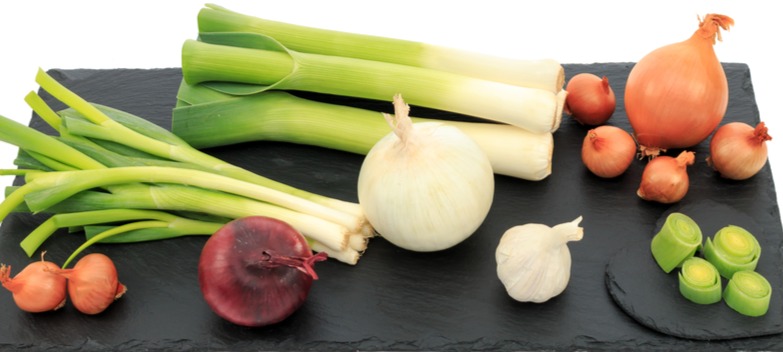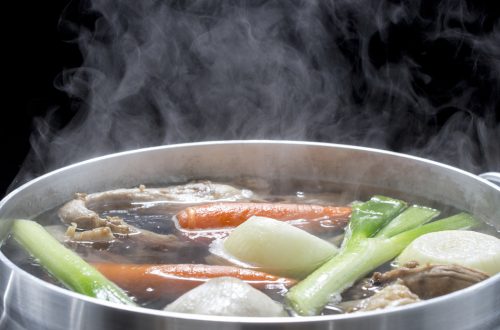
Everybody Loves Alliums
From your email, please click on the title to view the photos and comment online. On the Website, you can read past blogs, search for recipes, and browse.
Onions. They’ve been part of the human diet for 7,000 years, worshipped by the Egyptians and used as currency in the Middle Ages. Before New York City was the Big Apple, it was known as the Big Onion, a place where you could peel off layer after layer without reaching the core. Americans eat about 20 pounds per person annually, but the Libyans, world champs, eat three times as much.
The heart of dishes all over the world
Almost every seasonal major meal – spaghetti and sauce, beef stew, chicken pot pie, fish chowder – begins with a foundation of aromatics. The French have their mirepoix (onions, carrots, celery), and the Germans, suppengrün (literally, soup greens: carrots, leeks, celeriac). There’s the Cajun Holy Trinity (onions, green pepper, celery), the Asian trinity (ginger, garlic, scallions), and the Spanish/Latin American sofrito (onions, garlic, tomato). There are obviously other versions around the world, but universally, they all include alliums.
We’re talking about the bulbs of the plant family that includes foods you know as onions, leeks, scallions, shallots, garlic, and ramps. There are more than 600 different species in this plant family related to the amaryllis. Allium comes from the Latin word for garlic. The edible plants in this group are linked by their odor, a pronounced aroma – from sweet to piquant – caused by the sulfur compounds they contain. They’re also responsible for the vapors that cause your tears when chopping onions or shallots.
My meat-and-potatoes childhood family cuisine was not big on aromatics. In the Farm Journal Country Cookbook of that time, Chapter 1 is titled “Meats, The Menu Focus.” Recipes for braised pork did not include aromatics, though some basic beef pot-roast recipes did include onions. Growing up, my mother bought her yellow onions in a 10-pound bag that was kept in the pantry. That was it for alliums, for the most part. Occasionally, we would have scallions, but those were just for munching. For garlic flavor, we just used garlic salt.
Good enough to make you cry
These days, based on my cooking experiences, I have upped my game with the allium family. That means understanding how to make maximum use of each different type of allium and which one suits a particular dish.
- Yellow onions, the standard onion ingredient, have a sweet flavor and caramelize beautifully.
- Red onions can have a pungent flavor that is easily reduced by cutting them and rinsing them in a colander or pickling them.
- Sweet or Vidalia onions have a higher sugar content, making them great for sautéing or caramelizing.
- Shallots have a more delicate flavor, making them a better option for salads, stir-fries, and sautéed vegetables.
- Leeks, a long cylinder rather than a blub, are milder and can be used to build flavor or foster a lighter flavor in savory dishes. They can also be used as a side dish, either grilled, roasted, or incorporated into a soup.
- Scallions or green onions offer a mild onion flavor and are good raw options for salads or soups or added to stir-fries. The white bottoms pack more oniony flavor, while the green tops are a milder chive flavor. As for chives themselves, use the green tops for salads and soups.
- Then there’s garlic, another foundational allium and one of the most favored flavoring ingredients in cooking. When braised or cooked, it boosts the aromatic qualities and flavors of any dish. Grated or chopped raw, it adds a sharp flavor to a salad dressing or a slow roast.
Take the average yellow onion family. Cutting them opens the onion cells and releases the compounds that foster your tearing. Letting them sit for a few minutes allows that chemical reaction to finish and reduces the problem. You can also chill them before slicing or wash them in water to reduce the reaction. Soaking them in acid (lemon, tomatoes, vinegar) will also soften the harshness. When you are making a dressing, add your acid and wait for 15 to 20 minutes before adding oil.
Cooking onions low and slow in a fat triggers the caramelization process. The trick is to keep the heat warm enough to trigger caramelization and a sweet, soft result without burning the onions. For a stronger flavor, sauté the onions in butter for about 10 minutes to brown them slightly. I prefer the sweeter Vidalia onions for most recipes. I always keep some scallions ready for stir-fries and garnishes, and I have a patch of chives in my kitchen garden. I’ve also been incorporating leeks more into some of my recipes. And I really enjoy finding ways to use garlic.
Do you have a favorite way to eat alliums, or maybe a good onion story?
Please click on the headline to view the blog on the website. You can log in and comment at the end of the blog to share your thoughts and start a discussion, or suggest a topic for Farmboy in the Kitchen.
If you’d like to share the blog, click on the Facebook icon or one of the others. Thanks!





One Comment
Tom Stites
“The Little House on the Prairie” books have provided joy to several generations now, but did you know there’s a “Little House on the Prairie Cookbook?” I just checked Amazon and after almost 35 years since publication, it’s still in print. And several of the loving reader reviews mention my favorite recipe from it: Fried Apples and Onions.
If you have more than a passing interest in the Little House books I’d encourage you to buy the cookbook.
Meanwhile, the recipe, which has but four ingredients: fatback, onions, apples and brown sugar. To make a skilletful I usually use four onions and three apples that are about the same size — the onions cook down.
Fry the fatback to grease a frying pan, remove it, and pour off melted fat, leaving the pan with just a coating.
Slice onions as thin as you can — enough to cover the bottom of the pan after they’ve cooked down. Saute them until they start to carmelize. Core and slice enough sweet apples into circles a quarter-inch thick to cover the onions. Sprinkle the apples with the brown sugar, put a cover on the pan, place over low heat and steam till yur nose gets happy as a signal that they’re ready.
Now, a modern refinement: Instead of the fatback, fry a half pound of bacon; when done, set the strips aside on paper towels to drain.
Prepare the onions and apples as above, but before sprinkling the brown sugar, cover the onions and apples with the bacon strips. Then sprinkle the brown sugar and steam.
This has been a staple on my holiday tables for as long as the book has been in print. I often think I should make a skilletful and make a meal of just the fried appleds and onions — with bacon — plus my favorite cornbread and perhaps one side dish, perhaps roasted Brussels sprouts.